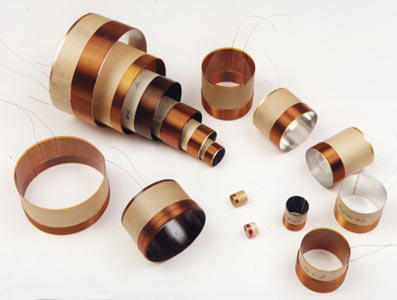Your Cart is Empty
NOW FREE SHIPPING TO 48 CONTIGUOUS UNITED STATES ON ALL ORDERS!!!
Paper or plastic? The Great Kapton vs. Paper Voice-coil Former Question!
by vaughn skow August 09, 2012 2 min read
First a little catch-up lesson: What exactly IS a "former" in a speaker anyway? It’s the tube that the voice-coil is wound around, that’s what. And, like old Rodney Dangerfield, it just doesn’t get any respect. In fact, most exploded-views of speakers don’t even LIST the former, giving the impression that the voice-coil is magically wound on nothing other than thin air!

Until about 1970, all speaker voice coils were wound on paper tubes. Paper has a nasty habit of burning up when it gets hot. The voice-coil is the part of the speaker that the output of the amplifier is directly fed to, and they get hot when driven hard. As amps began to get drastically more powerful, folks started to look for another material to wind the voice-coil on; one that could take a lot more heat. About that same time, DuPont developed a new polymer material, dubbed "Kapton", which remains stable up to about 725 degrees Fahrenheit. Kaptonquickly became the new de-facto material for voice-coil formers (plus a lot of other stuff from I.C. boards to spacecraft parts). On paper (get the pun) Kapton beats paper hands-down in all possible ways. It can be made thinner and stronger, it can take way more heat and mechanical stress, and has excellent dielectric properties. So, why would anyone offer a speaker like the WGS Black & Blue, with an old-fashioned vintage style paper former? Well...
Some folks would argue that the composition of the former does not affect the tone of the speaker. I personally feel there IS a noticeable tonal difference between the modern formers made of Kapton and the vintage style formers made of paper. The old paper former speakers, like the Celestion Blue and the Vintage American Made Jensens have a more open, airy top end. I’m not really the ultimate expert in this subject, but I know who is.
A while back I was talking with WGS production manager Dean Birdsong. Dean mentioned that he had just done some extensive studio listening tests comparing how the exact same speaker sounded with a Kapton Former vs. a vintage paper former. The speakers he had just compared were the WGS Black & Blue, and the WGS Blackhawk, which is essentially the exact same speaker except that it has a Kapton former, rather than the paper former of the Black & Blue. If I remember right, Dean’s exact words were: “Dang if you can’t hear the difference, the paper sounds brighter, and the Kapton sounds warmer.” Dean’s the man when it comes to speakers, he wouldn’t say it if he didn’t mean it.
So, there you have it. Why on earth would you want to choose the 15-watt Black & Blue over the 50-watt Blackhawk? Maybe because of that extra bit of effortless top-end shimmer! Just use wisely, it IS a 15-watt speaker.
My outside blog recommendation this week is from “how stuff works”. It’s a nice piece on speaker voice-coils, but notice that it does not mention what the voice-coil is wound on! http://electronics.howstuffworks.com/speaker5.htm
Leave a comment
Comments will be approved before showing up.
